
A pusher is a worker who pushes people onto the mass transportation vehicle at a crowded stop during the rush hours.

A pusher is a worker who pushes people onto the mass transportation vehicle at a crowded stop during the rush hours.
When pushers were first brought in at Shinjuku Station, they were called "passenger arrangement staff" (旅客整理係, ryokaku seiri gakari), and were largely made up of students working part-time; currently, station staff and/or part-time workers fill these roles during morning rush hours on many lines. [1] [2] During the run-up to the 1964 Summer Olympics in Tokyo, a special issue of LIFE magazine described a photograph by Brian Brake as showing "the Tokyo commuter trains where riders are squashed aboard by white-gloved official pushers." [3] In 1975, oshiya packed commuters into rush-hour trains that were filled to an average of 221 percent of designed capacity. [4]
Why, from the moment of starting, I have been mauled and hauled about by the crowds, and every conductor yelled at me, 'Step lively, step lively, lady,' and some even caught hold of me and jerked me on the car and then pushed me into the struggling crowd of passengers inside. 'Step lively,' indeed!
anonymous widow describing her New York City streetcar experience,The Spectator, c.1890s [5]
New York City conductors were well-known for using the phrase "step lively" to exhort passengers to clear space by the doors of streetcars and subway cars during the early 20th century, [6] dating back to the opening of the subway in 1904. [7] "Step lively" was seen as an overly imperative phrase that "flusters the timid and uncertain and angers those who desire to be courteously treated". [5] The New York Times advocated the use of "press forward" instead of "step lively" in 1908. [8]
Early legal precedent in New York held railway operators liable for injuries resulting from overcrowded platforms; since the operator controlled access to the platforms, they could limit the number of passengers on the platform and prevent crowds from pushing and potentially injuring passengers. [9] [10] Another New York decision held the operator would be blameless for the pressing action of the crowd, but noted that since the car had been subject to "forced augmentation" by an employee (the guard), the operator was held liable. [11] In Boston, a court ruled the schedule and convenience of other passengers meant that efforts to minimize station dwell time were justified, although physically packing passengers on trains was not mentioned. [12] [13]
A New York Times article from August 8, 1918, mentions subway guards and police trying to direct and push crowds onto trains operating along the new 42nd Street Shuttle service between Times Square and Grand Central. [14] By the 1920s, pushers in the New York City Subway were known worldwide, but were not well-liked due to their reputation as "sardine packers". [15] [16]
New York City subway pushers are depicted in the 1941 biographical movie Sergeant York ; George Tobias plays the character "Pusher" Ross, a soldier from New York City. In the film, "Pusher" has to explain his nickname to Alvin York – which he got because he pushes passengers onto the crowded subway cars during rush hours. The story takes place during World War I, which establishes that "Pusher" was a subway pusher in New York City prior to 1918. Also, in the Bugs Bunny cartoon Hurdy Gurdy Hare , Bugs dons a conductor's cap and pushes a gorilla while saying, "push in, plenty of room in the center of the car!", pausing to tell the audience "I used to work on the shuttle from Times Square to Grand Central". The cartoon was copyrighted in 1948 and released in 1950.
At least three cities in China have employed professional train pushers. The Beijing Subway has hired employees to help pack commuters onto train carriages since 2008. [17] [18] On the Shanghai Metro, trains running on Line 8 at up to 170% of capacity during peak hours in 2010 have used volunteers to help fill carriages. [19] In 2012, seven years after opening, crowds on Chongqing Metro trains were so thick that pushers were used during peak hours. [20]
In Japan, pushers are known as oshiya (押し屋). The term is derived from the verb osu (押す), meaning "push", and the suffix -ya (屋), indicating "line of work." Oshiya ensure every passenger has boarded and does not get caught in the doors, as described during a CNN interview with Sandra Barron, an American living in Tokyo. [21]
A 1995 New York Times article noted white-gloved oshiya were still being deployed during rush hours, but called them "tushy pushers", or shiri oshi (尻 押し). [2] Since 2000, rush-hour trains had become significantly less crowded, running at an average of 183 percent of capacity. [a] By 2019, severe crowding has been largely eliminated on Japanese train lines outside of Tokyo. Train lines in Tokyo have had significant reductions in overcrowding and now run at an average of 163 percent of capacity. [a] [22] This was driven by increased capacity (a system-wide 60% increase in 2000 compared to 1970), and changing passenger demand dynamics caused by stagnant growth since 1990s, declining population and commuter incentives designed to make off-peak hour trains more inviting. [4] This led to a decline in the number of pushers needed and largely confining them to the Tokyo area on some still extremely congested lines.
In February 2017, Madrid hired "pushers" in its Metro to cope with increased numbers of passengers. Line 8, which connects the Madrid–Barajas Airport to Madrid's city center, was temporarily closed due to maintenance works, which caused a surge of passengers on other lines. In Spanish, subway pushers are literally called "pushers" (empujadores); they help passengers embark and make sure that carriage doors are properly closed. Some observers immediately made comparisons with the Japanese oshiya. [23] [24]
The Metropolitan Transportation Authority hires "platform controllers" to direct crowds to minimize platform dwell times, although their duties do not include physically moving passengers. [25] [26] They perform similar duties as the subway guards, who performed similar duties in the subway through the 1940s. [16] [26]
Since 2015, Deutsche Bahn has been using pushers at Frankfurt's main train station (Frankfurt Hauptbahnhof) and at times at the Messe (trade fair) S-Bahn station and other highly frequented stations (e.g. Eschborn Süd). These platform attendants are called Einstiegslotsen (boarding guides; initially, they were called Fahrgastlenker, i.e. "passenger steerers"). As it was considered indelicate to actually "push" people forward physically, as is standard procedure e.g. in Tokyo-Shinjuku station, the Einstiegslotsen try to avoid direct physical contact. They concentrate on boosting passenger entry and barring the access to the closing doors to stop people trying to enter the full train.
a. ^ Crowding levels defined by the Ministry of Land, Infrastructure, Transport and Tourism: [27] [28]

The Tokyo Metro is a major rapid transit system in Tokyo, Japan, operated by the Tokyo Metro Co. With an average daily ridership of 6.84 million passengers, the Tokyo Metro is the larger of the two subway operators in the city; the other being the Toei Subway, with 2.85 million average daily rides.

The Tokyo Metro Chiyoda Line is a subway line owned and operated by Tokyo Metro in Tokyo, Japan. On average, the line carries 1,447,730 passengers daily (2017), the second highest of the Tokyo Metro network, behind the Tozai Line (1,642,378).
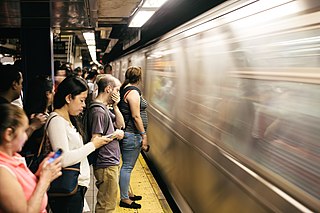
A rush hour or peak hour is a part of the day during which traffic congestion on roads and crowding on public transport is at its highest. Normally, this happens twice every weekday: once in the morning and once in the afternoon or evening, the times during which most people commute. The term is often used for a period of peak congestion that may last for more than one hour.

The Minatomirai 21 Line, commonly known as the Minatomirai Line, is a subway line in Yokohama, Japan that runs from Yokohama Station to Motomachi-Chūkagai Station through the Minatomirai 21 business district. The line opened in 2004 and is operated by the Yokohama Minatomirai Railway Company.

The Tokyo Metro Hibiya Line is a subway line in Tokyo, Japan, owned and operated by Tokyo Metro. The line was named after the Hibiya area in Chiyoda's Yurakucho district, under which it passes. On maps, diagrams and signboards, the line is shown using the color silver, and its stations are given numbers using the letter "H".

The Tokyo Metro Hanzōmon Line is a subway line in Tokyo, Japan, owned and operated by Tokyo Metro.
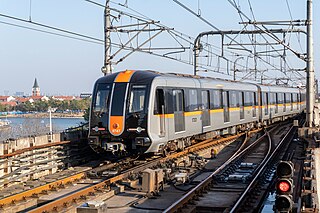
The Shanghai Metro (Chinese: 上海地铁; pinyin: Shànghǎi Dìtiě; Shanghainese: Zaon6he5 Di6thiq7) is a rapid transit system in Shanghai, operating urban and suburban transit services to 14 of its 16 municipal districts and to Kunshan, Jiangsu Province. Served as a part of Shanghai rail transit, the Shanghai Metro system is the world's biggest metro system by route length, totaling 802 kilometres (498 mi). It is also the second biggest by the number of stations with 408 stations on 19 lines. It ranks first in the world by annual ridership with 3.88 billion rides delivered in 2019. The daily ridership record was set at 13.29 million on March 8, 2019. Over 10 million people use the system on an average workday, even after COVID, accounting for 73% of public transport trips in Shanghai.
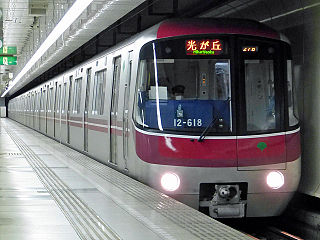
The Toei Ōedo Line is a subway line in Tokyo, Japan, operated by the Tokyo Metropolitan Bureau of Transportation (Toei). It commenced full operations on December 12, 2000; using the Japanese calendar this reads "12/12/12" as the year 2000 equals Heisei 12. The line is completely underground, making it the second-longest railway tunnel in Japan after the Seikan Tunnel.
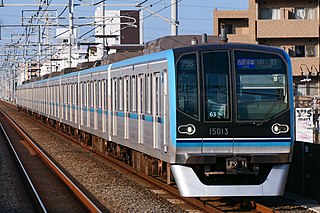
The Tokyo Metro Tozai Line is a rapid transit line in Tokyo and Chiba Prefecture, Japan, owned and operated by Tokyo Metro. Its name translates to "East-West Line". The line runs between Nakano in Nakano-ku, Tokyo and Nishi-Funabashi in Funabashi, Chiba Prefecture. The Tōzai Line was referred to as Line 5 during the planning stages; the seldom-used official name is Line 5 Tōzai Line. The line carries an average of 1,642,378 passengers daily (2017), making it the busiest line on the Tokyo Metro network. On maps, diagrams and signboards, the Tōzai Line is shown using the color "sky blue" and its stations are given numbers using the letter "T".

Line B of the Buenos Aires Underground runs 11.75 kilometres (7.30 mi) from Leandro N. Alem to Juan Manuel de Rosas in Villa Urquiza. Line B opened to the public on 17 October 1930.

Stamford station, officially known as the Stewart B. McKinney Transportation Center or the Stamford Transportation Center, is a major railroad station in the city of Stamford, Connecticut, serving passengers traveling on Metro-North Railroad's New Haven Line, Amtrak's Northeast Corridor, and CTrail's Shore Line East. In addition, it is also a major bus terminal for Greyhound, Peter Pan, and CTtransit buses. Annual ridership on Metro-North exceeded 8.4 million in 2016, making it the second busiest station in the entire system, after Grand Central Terminal.
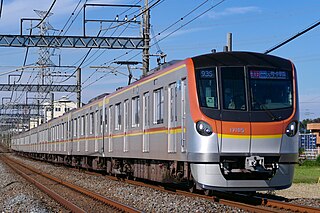
The Tokyo Metro Fukutoshin Line, formally the No. 13 Fukutoshin Line, is a 20.2-kilometer (12.6 mi) subway line operated by Tokyo Metro in west-central Tokyo and Wako, Saitama, Japan. The newest line in the Tokyo subway network, it opened in stages between 1994 and 2008. On average, the Fukutoshin Line carried 362,654 passengers daily in 2017, the lowest of all Tokyo Metro lines and roughly one third of its sister Tokyo Metro Yūrakuchō Line (1,124,478).

Women-only passenger cars are railway or subway cars intended for women only. They are a result of sexual segregation in some societies, but also can result from attempts to reduce sexual harassment and assault such as groping.

The Toei Mita Line is a subway line of the Tokyo Metropolitan Bureau of Transportation (Toei) network in Tokyo, Japan. The line runs between Nishi-Takashimadaira in Itabashi and Meguro in Shinagawa. Trains continue with direct service into the Meguro Line of Tokyu Corporation for Hiyoshi. The portion between Shirokane-Takanawa and Meguro is shared with the Tokyo Metro Namboku Line.

The Toei Shinjuku Line is a rapid transit line in Tokyo and Chiba Prefecture, Japan, operated by Tokyo Metropolitan Bureau of Transportation (Toei). The line runs between Motoyawata Station in Ichikawa, Chiba in the east and Shinjuku Station in the west. At Shinjuku, most trains continue as through services to Sasazuka Station on the Keiō New Line, with some services continuing to Hashimoto Station in Sagamihara, Kanagawa via the Keiō Line and the Keiō Sagamihara Line.

Platform screen doors (PSDs), also known as platform edge doors (PEDs), are used at some train, rapid transit and people mover stations to separate the platform from train tracks, as well as on some bus rapid transit, tram and light rail systems. Primarily used for passenger safety, they are a relatively new addition to many metro systems around the world, some having been retrofitted to established systems. They are widely used in newer Asian and European metro systems, and Latin American bus rapid transit systems.
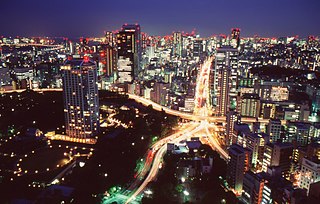
The transport network in Greater Tokyo includes public and private rail and highway networks; airports for international, domestic, and general aviation; buses; motorcycle delivery services, walking, bicycling, and commercial shipping. While the nexus is in the central part of Tokyo, every part of the Greater Tokyo Area has rail or road transport services. There are also a number of ports offering sea and air transport to the general public.
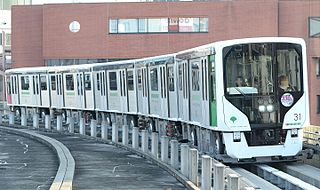
The Nippori-Toneri Liner is an automated guideway transit (AGT) system between Nippori Station in Arakawa and Minumadai-shinsuikōen Station in Adachi, Tokyo, Japan. The line opened on 30 March 2008. It is operated by the Tokyo Metropolitan Bureau of Transportation (Toei).
A limited express is a type of express train, and express bus service. It refers to an express service that stops at a limited number of stops in comparison to other express services on the same or similar routes.

A crush load is a level of passenger loading in a transport vehicle which is so high that passengers are "crushed" against one another. It represents an extreme form of passenger loading, and normally considered to be representative of a system with serious capacity limitations. Crush loads result from too many passengers within a vehicle designed for a much smaller number. Crush loaded trains or buses are so heavily loaded that for most passengers physical contact with several other nearby passengers is impossible to avoid.
Busy stations not only deploy "door pushers" to help commuters squeeze into the carriages during peak times but also limit the number of passengers on the platforms out of safety concerns.